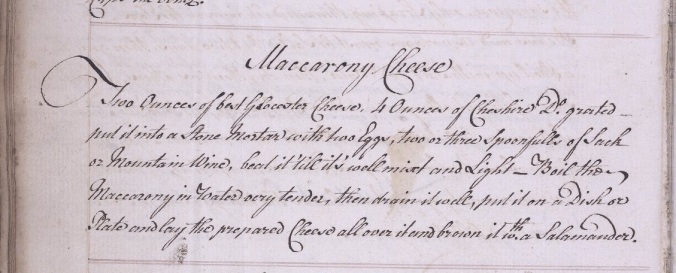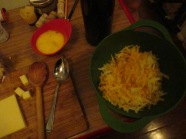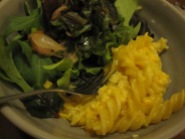
Photo by Carley Storm Photography http://www.carleystormphotography.com
For our inaugural recipe, we thought, why not start with an eighteenth-century mac-and-cheese? It’s a modern-day American classic and perhaps the ultimate comfort food.
This recipe comes from UPenn Ms. Codex 1038, a collection of recipes most likely written and bound between 1765 and 1830. (Thanks to Mitch Fraas for pointing us to this particular “maccarony cheese.”)
The Recipe
Maccarony Cheese
Two Ounces of best Glocester Cheese, 4 Ounces Cheshire Do. grated – put it into a Stone Mortar with two Eggs, two or three Spoonfulls of Sack or Mountain Wine, beat it ’till it’s well mixt and Light – Boil the Maccarony in Water very tender, then drain it well, put it on a Dish or Plate and lay the prepared Cheese all over it and brown it with a Salamander.
This recipe, unlike some others to be featured, discussed, and puzzled over here in the next few months, features no ingredients that are mysterious, challenging to obtain, or downright unappetizing. Cheese, eggs, and macaroni are all familiar. Even sack wine can be approximated. Defined in Samuel Johnson’s 1737 Dictionary as “A kind of sweet wine, now brought chiefly from the Canaries.” Also known as “Canary wine,” sack identified a few varieties of sweet, fortified light wine. One of these later became known as “sherry,” so sherry is what we turned to here. For Gloucester cheese, we substituted a sharp, aged cheddar; for Cheshire, a milder cheddar.
Note that although the recipe provides specific measurements for all ingredients of the cheese sauce, the amount of macaroni is left unspecified. Based on the amount of cheese sauce, we determined that approximately half a pound of pasta (ex. fusili) would most likely have been used.
Early modern cooks used salamanders to brown dishes. A salamander was a piece of cast iron with a handle attached; it would be heated in the fire and then held on top of a dish to warm it. Essentially, a salamander was a hand-held broiler. We debated using a culinary torch but decided that an oven would provide more even cooking.
So, our modern version of the recipe looked like this:
2 oz. sharp/dry cheddar
4 oz. mild cheddar
2 eggs
2 tsp. sherry
8 oz. dried pasta
Heat oven to 350F.
Grate the cheeses and beat together with eggs and sherry. Add salt and pepper to taste. Cook and drain pasta.
Transfer pasta to oven-proof dish and evenly distribute cheese sauce over the top. Bake for 15-20 minutes, until cheese is melted and lightly browned.
The Results
In a word: delicious. The eggs cooked with the cheese to form a dense, satisfying mac-and-cheese that was remarkably easy to make. And the sherry flavor came through in a unique, rich way. We both agreed that this would be an easy way to throw together a pasta dish for one or two people, using up any scraps of cheese. Even more impressive: unlike many modern recipes for mac-and-cheese, this one does not involve any milk or heavy cream.





Looks delicious!
Thanks! It was very tasty. We highly recommend trying it.
Reblogged this on DailyHistory.org and commented:
Alyssa Connell and Marissa Nicosia at Cooking in the Archives brings an early recipe for Maccarony Cheese. Instead of using a béchamel as the basis for the cheese sauce, the recipe uses eggs. Not only does it look appetizing, it was easy to make.
Thanks for reblogging! We hope you and the DailyHistory.org readers try out this recipe and enjoy it.
I’ve been doing some historic cooking for LRP events with my friend Dom and he says ‘macarons’ are rectangles and the way he’s done this dish was to weave fresh lasagne sheets. cut into strips, rather than with fusilli, and to weave the pasta into a tasty tasty mat of tastiness. It’s a common medieval recipe and may be found in medieval cookbooks — we can give a citation if needed!
Thanks, L! That’s really interesting. Definitely post your source here.
I want to hear about that arugula salad recipe. Also, in an act of ahistoricist surface reading, I plan to cook this with the kind of salamanders that first came to mind.
We’re curious whether waving a live salamander back and forth over the top of the dish cooks it through. Please report back.
We at “Cooking in the Archives” cannot officially condone the cooking of salamanders. But let us know how it turns out!
Delicious! I’ve cooked some 17th and 18th century recipes (mostly Hannah Woolley) in the past. It’s quite enjoyable to translate something a bit archaic into a workable recipe!
Thanks, Lauren! We’re preparing some fun summer-y posts for the next few weeks so stay tuned.
Looking forward to trying this – kids friendly AND historical. I am not sure I have the patience to weave lasagna mats, though.
Let us know how it goes! (Whether you choose to weave lasagna mats or use another “maccarony.”
Pingback: Could Possett | Cooking in the Archives
Sounds good, but why did you bother to substitute the Gloucester and Cheshire with Cheddar? it’s not as though they aren’t both readily available. I know supermarkets only carry about 40 types of cheese but double Gloucester and Cheshire are usually common enough to be in the cheap range too…
We love Gloucester and Cheshire, but we decided to substitute because neither cheese is cheap or readily available in Philadelphia grocery stores. I fondly remember picking up those very cheeses in the supermarket when I lived in the UK. Be sure to let us know what mix of cheese you use if you try the recipe!
Wow, the idea of Gloucester and Cheshire being expensive hadn’t occurred to me as they’re staples on my shopping list… Cheshire cheese being the perfect accompaniment [and traditional in Yorkshire, it being a Yorkshireman who introduced me to it] to apple pie. Also Christmas cake, but it’s not that time of year… I’ll be sure and write. I’ve now discovered a source of gluten free pasta [we have gluten issues in the family] also in the local supermarket, so it’s back on the menu! I look forward to reading more of your blog, having also discovered it through the 2 Nerdy History Girls
Love this new blog! Regarding the size and shape of macaroni at the time… according to Thomas Jefferson’s notes and illustrations, it appears that it was made in long narrow tubes that were then cut into short lengths. For Jefferson’s notes and illustration of a pasta machine, follow the link: http://classroom.monticello.org/kids/gallery/image/188/Notes-on-Macaroni-and-a-Macaroni-Machine/
Thanks for sharing Jefferson’s macaroni notes! And stay tuned, we’ve cooked some more excellent recipes that we’re excited to share here.
This is so interesting, thanks! Perhaps someday we’ll try making our own “maccarony.”
Wow I found this blog through 2 Nerdy History Girls, and I am so glad I did I love historical cooking 🙂 I am so excited to read more of your posts just after this one!
Thanks for reading! We’ve done a lot more cooking and we’re preparing some fun posts.
Thanks! And glad to have you here. We’re having a great time with the project.
Are y’all thinking about doing older recipes? I’ve done a few from the Form of Curry, and they are fun to make as well as eat 🙂
the forme of cury is available online, I too have cooked from it from time to time. interesting to find that they had macaroni in Richard II’s time, called Macrows in the forme of cury
Yeah there is a lot of debate on how and when pasta originated and when certain shapes/ingredients were spread culturally. It seems to be like pyramid structures, fire, or bread, everyone had some form of it but don’t know where they got it. Even Galen had a recipe for it as part of his medicine. There still doesn’t seem to be a definite pasta discovery owner (sorry China!) but who cares it is really good 😀 and is really neat. Can’t wait for the next post!
Pingback: Fish Custard | Cooking in the Archives
Pingback: Speaking of food… « Whipped Cream Difficulties
In the restaurant “biz”, as it were, I’ve heard people refer to broilers as salamanders quite often.
Like dis one:
http://www.amazon.com/Garland-GIR60LP-Salamander-Broiler-Restaurant/dp/B004W6KKHG
Interesting! Who knew that we could find a salamander on Amazon.
I am glad you defined what the salamander was, that caught me totally off guard there. My mom loved Cheshire cheese and so paid the high price for only a little of it . In the US such cheese is not cheap as it’s imported to US stores. I wouldn’t need the quantity here, but would reduce portions a lot. We wouldn’t go with the wine, but would use milk instead.
One of the great things about this recipe is that you can adjust the proportions to however many servings you’d like to make. I’m looking forward to making mac-and-cheese for one once the weather cools down!
In the Carrot Pudding recipe, the word “cittern” seems to be the fruit “citron.” Candied citron is readily available today in the baking section of supermarkets and used in fruit cake, for example.
Pingback: a question of “updating” | marginal notes
A salamander was made of iron, usually with a round piece at one end of a long handle. It was used to brown the TOP of a dish, ONLY. It was not for cooking/baking a dish. I’d post an image, if I knew how! dagnabit
You can see one being used here, however (scroll down a ways): http://historiccookery.com/2014/08/14/18th-century-chocolate-a-beverage-and-a-food/
cheers!
historiccookery.com
Reblogged this on Kitchen Dilettante and commented:
“Cooking in the Archives” is a blog after my own food history-loving heart. This pair of bloggers take old recipes from the 1600s to the 1800s and “translate” them to modern-day measurements, ingredients, and language so the rest of us can understand them. Check out the recipe for “Maccarony Cheese” from the 1700s and their updated version. Very cool.
Pingback: Herb Soop | Cooking in the Archives
Pingback: To make Little Cakes, Cooking in the Scripps Archives Part 1 | Cooking in the Archives
Pingback: Food: The happiest of traditions - Topiik
Pingback: Bread and Butter Puddings | Cooking in the Archives
Reblogged this on Mrs B's Bits&Bobs and commented:
Just came across this recipe on one of my favourite blogs. It sounds delicious and I can’t wait to try it. You should check out their awesome blog it is full of delicious and enchanting old recipes. Great stuff!
This sounds truly awesome and I can’t wait to try it! I have reblogged your recipe on mine – Mrs B’s Bits & Bobs. Hope you don’t mind. Love your blog and all your recipes. x
Pingback: Carrott Puff. | Cooking in the Archives
Pingback: [Перевод] Какой была на вкус еда семнадцатого века? — iT ОБОЗРЕВАТЕЛЬ
Pingback: Cooking in the Archives | ifihadafoodblog
Pingback: Turnips and carrots, For a ffridays dish of meat | Cooking in the Archives
Pingback: Britain’s European food connection pre-dates the EU and will survive Brexit – Famous Finds
Pingback: Britain’s European food connection pre-dates the EU and will survive Brexit – The King's Dinners
Pingback: Your Kitchen is a Time Machine: An interview with Marissa Nicosia of Cooking in the Archives – ars longa